
Trees play a critical role in all terrestrial ecosystems and supply a variety of products and services to both rural and urban populations. As natural vegetation is chopped down for agriculture and other forms of development, the advantages of trees are best preserved by incorporating trees into agricultural systems, a method known as agroforestry.
Farmers have practiced agroforestry since ancient times. Agroforestry focuses on the wide range of trees grown on farms and other rural areas. Agroforestry is a collective name for land-use systems involving trees combined with crops and/or animals on the same unit of land.
Benefits of Agroforestry
Environment Benefits: On agricultural farms, combining trees with food crops yields a number of significant environmental advantages, both in terms of overall ecological benefits and specific on-site benefits. It includes improving the microclimate by using a mixture of mulching and shade to lower soil surface temperature and reduce the loss of soil moisture.
Economic Benefits: Agroforestry systems on cropland/farmland provide major economic advantages to farmers, communities, regions, and countries. Added food, fertilizer, fodder, fuelwood, and timber outputs, as well as increasing levels of farm incomes due to improved and sustained productivity.
Social Benefits: Besides the economic benefits, social benefits occur from an increase in crop and tree product yields and in the sustainability of these products. These benefits include:
-
Development in rural living standards from sustained employment and higher incomes
-
Enhancement in nutrition and health due to increased quality and diversity of food outputs and Maintenance and improvement of upland communities through the elimination of the need to shift sites of farm activities.
Types of Agroforestry in non-forest areas
1. Farm Forestry: Farm forestry is the practice of planting trees on farms in the form of bunds or field boundaries, individual trees on private agricultural land, and windbreaks, which are protective vegetal screens created around a farm or orchard by planting one or two lines of trees fairly close together with shrubs in between.
2. Extension Forestry: Extension forestry is the practice of forestry in regions devoid of tree growth and other flora, located outside of traditional forest areas, with the goal of expanding the amount of land under tree growth. It includes the following
-
Mixed forestry: It is the practice of forestry for raising fodder grass with dispersed fodder trees, fruit trees, and fuel-wood trees on appropriate wasteland, panchayat land, and village commons land.
-
Shelter belts: Shelter belts are defined as "a belt of trees and/or plants maintained for the purpose of providing protection from the wind, sun, snowdrift, and other elements." They are usually bigger than windbreaks, encompassing areas greater than a single farm and, in some cases, entire regions in a planned design.
-
Linear Strip Plantation: These are plantations of fast-growing species on linear strips of land on the sides of railway lines, canals and public roads.
3. Rehabilitation of Degraded forests:
For ecological restoration and to address the socio-economic demands of the populations living in and near degraded forest regions, quick attention is required. Rehabilitation of degraded forests is one of the possible pathways to recover the livelihoods of poor farmers and others in rural societies.
4. Recreation Forestry:
It is a type of forestry in which flowering trees and shrubs are grown primarily to serve as recreation forests for both urban and rural populations this type of forestry is also known as Aesthetic forestry, which is defined as practices of forestry with the goal of producing or preserving a forest of great aesthetic value, is another name for this form of forestry.
















